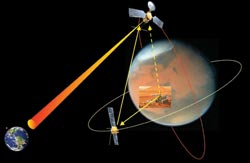Free-space optical communications and the final frontier
The origins of free-space optical communications can be traced back to the late 19th century, with the introduction of Alexander Graham Bell’s “photophone” and the optical telegraph. Both of these technologies went the way of the daguerreotype, but the idea of communications systems based on light traveling freely through space survived. The invention of the laser nearly 50 years ago offered renewed possibility, and today the technology is helping to advance a number of communications applications.
Free-space optics holds a number of advantages for such applications. First, it offers data rates comparable to those afforded by fiber optics, typically with considerably lower deployment costs. The point-to-point transmission and narrow beam make it difficult to intercept the signal. Also, operators do not need to obtain licenses for free-space optics communications systems – as with radio and microwave systems, for example.
A range of applications, therefore, could benefit from use of free-space optical communications systems, including LAN-to-LAN connections on campuses or in dense urban areas.
And then there are space applications, such as transmission of data between remote spacecraft and stations on or near Earth. Planetary probes such as the Messenger spacecraft, which recently completed a flyby of Mercury, generate countless photos and other images, and sending the image data back to Earth presents a tremendous challenge.

The NASA Jet Propulsion Laboratory is developing free-space optical communications systems for data transmission between Earth and Mars, for example. Shown here is an artist concept demonstrating high-data-rate trunk-line links from the planet’s orbit to the ground, from surface to orbit, and direct to the Earth from the surface.
Until recently, engineers designing space-bound communications systems have had to rely on radio links operating in the X or Ka band. Data links using free-space optics can offer significantly increased transmission capacity, however – from hundreds of kilobits to several megabits per second, and sometimes even higher. Currently, they are considering optical data links primarily for the downlink because the volume of data transmitted is much greater there than with the uplink.
The next generation of space communication
The NASA Jet Propulsion Laboratory (JPL) in Pasadena, Calif., devotes considerable time and energy developing laser communication technology for data transmission between Earth and space assets at planetary distances. One of the investigators’ primary efforts in this area, said Hamid Hemmati, supervisor of the optical communications group at the laboratory, is a laser-based system for a possible Mars mission – a “trunk line from Mars,” as he called it.
The researchers are developing a system offering a high data rate – 0.5 Gb per second from the shortest distance to Mars; the data rate decreases as the distance increases. This represents a factor of 10 improvement in data rate over existing systems, Hemmati said, with the same mass and power consumption. In some cases, it might even offer a factor of 50 or so improvement.
He noted, however, that it may be some time before the system actually is used on a Mars mission, and then only as “another tool in the toolbox”; the laser-based system will not replace radio links. “At least two or three demonstrations are needed before a spacecraft manager will feel comfortable making a laser-based system the primary telecommunications system,” he said. “We haven’t yet completed one.”
Unique challenges
The optical communications group is working on a variety of technology programs geared toward deep-space applications. Such applications present a number of challenges, however.
Not the least of these are mass and power consumption. With near-Earth communications systems, solar cells provide a relative abundance of power. Spacecraft receive less sunlight, however, as they go deeper into space, “so you have to use thermonuclear generators beyond Mars,” Hemmati said, “and those things are limited in power.” For this reason, and because of the low mass requirements of deep space probes, it is necessary to make the communications systems as efficient as possible. To this end, the group is using, for example, lightweight materials offering the required structural integrity and low thermal expansion.
Perhaps the most significant challenge the researchers face is in the area of laser beam pointing. From Mars distances, the beam must be pointed with accuracy on the order of a fraction of a microradian – roughly 1/30,000 of a degree. Spacecraft platform disturbances often exacerbated by extreme thermal fluctuations make achieving the needed accuracy a formidable challenge for which the JPL team has developed strategies that await validation from a deep-space mission.